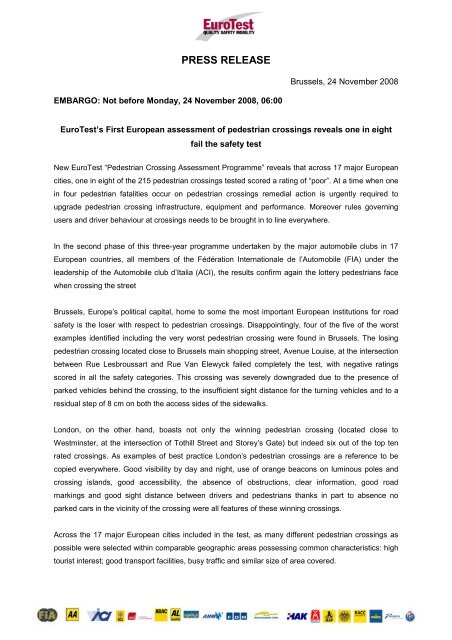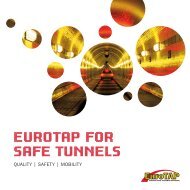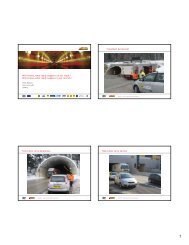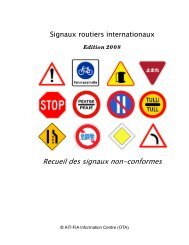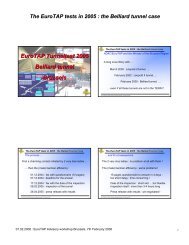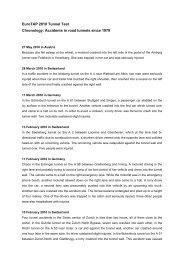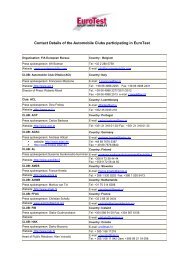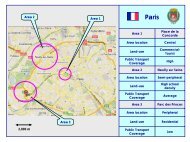PRESS RELEASE - EuroTest
PRESS RELEASE - EuroTest
PRESS RELEASE - EuroTest
You also want an ePaper? Increase the reach of your titles
YUMPU automatically turns print PDFs into web optimized ePapers that Google loves.
<strong>PRESS</strong> <strong>RELEASE</strong><br />
EMBARGO: Not before Monday, 24 November 2008, 06:00<br />
Brussels, 24 November 2008<br />
<strong>EuroTest</strong>’s First European assessment of pedestrian crossings reveals one in eight<br />
fail the safety test<br />
New <strong>EuroTest</strong> “Pedestrian Crossing Assessment Programme” reveals that across 17 major European<br />
cities, one in eight of the 215 pedestrian crossings tested scored a rating of “poor”. At a time when one<br />
in four pedestrian fatalities occur on pedestrian crossings remedial action is urgently required to<br />
upgrade pedestrian crossing infrastructure, equipment and performance. Moreover rules governing<br />
users and driver behaviour at crossings needs to be brought in to line everywhere.<br />
In the second phase of this three-year programme undertaken by the major automobile clubs in 17<br />
European countries, all members of the Fédération Internationale de l’Automobile (FIA) under the<br />
leadership of the Automobile club d’Italia (ACI), the results confirm again the lottery pedestrians face<br />
when crossing the street<br />
Brussels, Europe’s political capital, home to some the most important European institutions for road<br />
safety is the loser with respect to pedestrian crossings. Disappointingly, four of the five of the worst<br />
examples identified including the very worst pedestrian crossing were found in Brussels. The losing<br />
pedestrian crossing located close to Brussels main shopping street, Avenue Louise, at the intersection<br />
between Rue Lesbroussart and Rue Van Elewyck failed completely the test, with negative ratings<br />
scored in all the safety categories. This crossing was severely downgraded due to the presence of<br />
parked vehicles behind the crossing, to the insufficient sight distance for the turning vehicles and to a<br />
residual step of 8 cm on both the access sides of the sidewalks.<br />
London, on the other hand, boasts not only the winning pedestrian crossing (located close to<br />
Westminster, at the intersection of Tothill Street and Storey’s Gate) but indeed six out of the top ten<br />
rated crossings. As examples of best practice London’s pedestrian crossings are a reference to be<br />
copied everywhere. Good visibility by day and night, use of orange beacons on luminous poles and<br />
crossing islands, good accessibility, the absence of obstructions, clear information, good road<br />
markings and good sight distance between drivers and pedestrians thanks in part to absence no<br />
parked cars in the vicinity of the crossing were all features of these winning crossings.<br />
Across the 17 major European cities included in the test, as many different pedestrian crossings as<br />
possible were selected within comparable geographic areas possessing common characteristics: high<br />
tourist interest; good transport facilities, busy traffic and similar size of area covered.
“The findings of this assessment,” said Caroline Ofoegbu, FIA European Bureau, “underline the<br />
urgency of the European automobile clubs’ demand that pedestrian crossings be made safe places for<br />
pedestrians to cross the street. 8,000 pedestrians in Europe are killed in road accidents annually. One<br />
in four of these fatalities occur on or close to pedestrian crossings. Sadly it is the most vulnerable of<br />
this vulnerable group of road users that are most at risk, children, the elderly and those with<br />
disabilities. Any pedestrian fatality is unacceptable. Action is needed to curtail this problem.”<br />
<strong>EuroTest</strong>’s pedestrian safety observatory reveals that in 2006 Slovenia topped the ranking of<br />
pedestrian fatalities (on and outside pedestrian crossings) with a ratio of 18.0 per 1 million people.<br />
Spain, Austria and Italy followed with a ratio of 13.7, 13.3 and 12.6 respectively. In terms of fatalities<br />
on pedestrian crossings Luxembourg, Finland and Norway scored the highest rates.<br />
Observing this critical situation <strong>EuroTest</strong> partners recommend that not only city planners, and<br />
administrations act to improve pedestrian crossings but also that politicians and legislators should look<br />
to develop common traffic rules governing behaviour on and around pedestrian crossings for both<br />
pedestrians and drivers. A common understanding of rights and duties among Europe’s citizens<br />
currently cannot exist. Areas in need of improvement include:<br />
- Planning of pedestrian crossings, both location and layout are key to a comprehensive<br />
system of pedestrian mobility within the framework of the entire urban mobility planning.<br />
Planning should aim at solutions to the safety needs of pedestrians.<br />
- Good visibility at pedestrian crossings should be one of the design guidelines.<br />
- Pedestrian crossings should be systematically maintained in good conditions, meeting high<br />
requirements of safety.<br />
- Conflict resolution between pedestrians and other road users, in particular cyclists and<br />
trams.<br />
- Common behavioural rules to be adopted Europe wide<br />
- Simpler and better regulations governing the pedestrian/driver relationship in order to avoid<br />
confusion and potential dangers for tourists and foreign visitors. A European citizen, of British<br />
nationality, for example, knows that at home, he has the right of way from the moment he is<br />
standing on a sidewalk, waiting to cross. However, a Brit adopting such behaviour in Italy<br />
would be in very danger since drivers are obliged to yield the right of way only to pedestrians<br />
who are already crossing the street.<br />
In support of this campaign and to alert both pedestrians and drivers to the best practices to be<br />
adopted on and around pedestrian crossings, <strong>EuroTest</strong> is launching “Walk Safe” a new leaflet<br />
containing tips for both drivers and pedestrians.<br />
For more information about the <strong>EuroTest</strong> Assessment of Pedestrian Crossings visit<br />
http://eurotestmobility.com/eurotest.php?itemno=278<br />
ENDS
Notes to editors<br />
1. The pedestrian crossings test was between July and September 2008 in 17 major European cities:<br />
Amsterdam, Barcelona, Berlin, Brussels, Copenhagen, Helsinki, Ljubljana, London, Madrid,<br />
Munich, Oslo, Paris, Rome, Stockholm, Vienna, Zagreb and Zurich. Overall results showed that 28<br />
crossings out of 215 (one in 8) failed the test, achieving a “poor” rating. Just more than half<br />
crossings (118) were rated positively. Only two crossings earned a “very good” rating. 69<br />
crossings were considered “Acceptable”.<br />
2. A marked finding of this survey was the very wide degree of variation in the quality of the<br />
pedestrian crossings examined in each city is reflected in the range of ratings given. Cities such<br />
as Berlin and Brussels receive rating raging from “poor” to “good”.<br />
3. The study has established a Europe wide quality and safefy benchmark for pedestrian crossings<br />
which allows for further assessments to be conducted in the future.<br />
4. The methodology developed by ACI – Italian Motoring Club and “la Sapienza” University of Rome<br />
aimed at assessing the safety levels of single pedestrian crossings. Crossings were selected<br />
inside well defined areas of each city according to: high touristic interest, good transport facilities,<br />
existence of critical traffic situations and similar dimensions of the areas. The tests tried to cover<br />
all kinds of crossings (signalised/non-signalised, intersection/road link, one-way/two way roads,<br />
and one lane/multi T lane per direction) and were conducted during both day and night time. Each<br />
crossing was assessed for its safety taking into account its peculiarities in terms of spatial and<br />
temporal design, day and night time visibility and accessibility for all road users.<br />
5. The results published here represent the second phase of a three year study co-financed by the<br />
FIA Foundation that aimed at develop a full assessment programme for examining the quality and<br />
safety of Europe’s pedestrian crossings.<br />
6. This three year project produced in year 1, a “State of the Art” overview of the current situation of<br />
pedestrian crossings in Europe (task lead by TCS in collaboration with ACI). In years 2 and 3,<br />
pedestrian crossings facilities in major European cities will be assessed (task lead by ACI in<br />
collaboration with TCS).<br />
7. For more on the statistical findings on pedestrian fatalities visit:<br />
http://eurotestmobility.com/eurotest.php?itemno=278<br />
8. Through <strong>EuroTest</strong>, 18 automobile clubs in 17 countries, members of the FIA, have been putting<br />
the quality and safety of mobility in Europe to the test since 2000 for the benefit of their members<br />
and all mobile consumers in Europe. The <strong>EuroTest</strong> partners have constantly called for a Europe<br />
where the mobile consumer can circulate freely using quality infrastructure and in safety.<br />
For more information please see press contacts below:<br />
Organisation: FIA European Bureau Country : Belgium<br />
press spokesperson: Caroline Ofoegbu Tel: +32 2 282 0815<br />
website : www.eurotestmobility.com E-mail: info@eurotestmobility.com<br />
Club: The AA Country : The United Kingdom<br />
press spokesperson: Paul Watters E-mail: paul.watters@theaa.com<br />
website: http://www.theaa.com<br />
Tel: +44 1256 493 491<br />
Tel +44 1256 493 493 (24 hour media line)<br />
CLUB: Automobile Club D'Italia (ACI) Country: Italy<br />
press spokesperson: Paolo Borgognone E-mail: p.borgognone@aci.it<br />
website: http://www.aci.it Tel: + 39 06 4998 2277 Fax: +39 06 4998 2513
Head of Public Relations: Vincenzo Leanza Tel: +39 06 4998 2288 Fax: +39 06 4470 0885<br />
Director of Press: Roberto Miceli<br />
Tel.: +39 06 4998 2277- 2511- 2512<br />
Fax: +39 06 4998 2513<br />
e-mail: r.miceli@aci.it<br />
Club: ACL Country: Luxembourg<br />
press spokesperson: Dina Freitas E-mail: dfreitas@acl.lu<br />
website: Http://www.acl.lu Tel: +352 45 0045 218<br />
CLUB: ACP Country: Portugal<br />
press spokesperson: Mário Martins da Silva E-mail: mario.m.silva@acp.pt<br />
website: http://www.acp.pt Tel: +351 21 318 01 31/ Fax: +351 21 318 01 33<br />
CLUB: ADAC Country: Germany<br />
press spokesperson: Andreas Hölzel E-mail: Andreas.hölzel@adac.de<br />
<br />
<br />
website: http://www.adac.de<br />
http://www.presse.adac.de<br />
Tel.: 0049 89 7676 5387, Fax: 7676 8840<br />
CLUB: AL Country: Finland<br />
press spokesperson: Susanna Suokonautio-<br />
Hynninen<br />
website: http://www.autoliitto.fi<br />
E-mail: susanna.suokonautiohynninen@autoliitto.fi<br />
Tel: +358 9 72 58 44 44<br />
Fax: +359 9 72 58 44 60<br />
CLUB: AMZS Country: Slovenia<br />
press spokesperson: France Kmetic E-mail: france.kmetic@amzs.si<br />
website: http://www.amzs.si<br />
Tel: + 386 1 530 5252<br />
Fax: +386 1 530 5413<br />
CLUB: ANWB Country: Netherlands<br />
press spokesperson: Markus van Tol Tel: +31 70 314 6288<br />
website: http://www.anwb.nl E-mail: persdienst@anwb.nl<br />
CLUB: FDM Country: Denmark<br />
press spokesperson: Søren W. Rasmussen Tel: +45 45 27 07 73 Fax: +45 45 27 09 89<br />
website: http://www.fdm.dk E-mail: swr@fdm.dk<br />
CLUB: FFAC Country: France<br />
press spokesperson: Christian Scholly Tel: +33 3 88 36 0434<br />
website: www.automobileclub.org E-mail: cscholly@automobileclub.org<br />
CLUB: HAK Country: Croatia<br />
press spokesperson: Darko Brozovic E-mail: arc@hak.hr<br />
website: Http://www.hak.hr Tel: + 385 1 66 11216<br />
E-mail: vojvodic@hak.hr<br />
Head of Public Relations: Alan Vojvodić Tel: + 385 1 66 11 942<br />
Gsm: +386 99 21 18 008<br />
CLUB: M Country: Sweden
press spokesperson: Niklas Fredriksson E-mail: niklas.fredriksson@motormannen.se<br />
website: http://www.motormannen.se Tel: +46 8 690 38 33 Fax: +46 8 690 38 24<br />
CLUB: NAF Country: Norway<br />
press spokesperson: Egil Otter E-mail: egil.otter@naf.no<br />
website: http://www.naf.no<br />
Mobile Tel: +47 918 08 505<br />
Office Tel: ++47 22 34 14 00<br />
CLUB: ÖAMTC Country: Austria<br />
press spokesperson: Willy Matzke E-mail: willy.matzke@oeamtc.at<br />
Website: Http://www.oeamtc.at<br />
Tel: + 43 1 711 99 1310<br />
Fax: +43 1 711 99 1270<br />
CLUB: RACC Country: Spain<br />
Press Spokesperson: Josep Maria Miret<br />
Communication Manager: Maria Josep<br />
Coral<br />
website: Http://www.racc.es<br />
E-mail: jm.miret@racc.es<br />
Tel: + 34 93 495 5029<br />
Fax: +34 93 448 2490<br />
CLUB: RACE Country: Spain<br />
press spokesperson: Antonio Lucas E-mail: antonio_lucas@race.es<br />
website: http://www.race.es/<br />
http://www.seguridadvial.org<br />
Tel: + 34 91 594 75 62<br />
Fax: + 34 91 594 73 19<br />
CLUB: Touring (TCB) Country: Belgium<br />
press spokesperson: Danny Smagghe E-mail: danny.smagghe@touring.be<br />
website: http://www.touring.be Tel: +32 2 233 24 78 / Fax: +32 2 233 25 86<br />
CLUB: TCS Country: Switzerland<br />
press spokesperson: Thierry Pucci E-mail: tpucci@tcs.ch<br />
website: Http://www.tcs.ch<br />
Tel: 0041 31 380 1141<br />
fax 0041 31 380 1146


